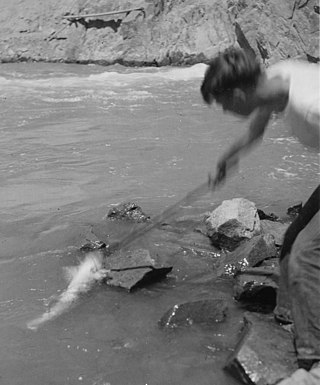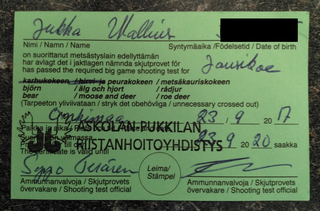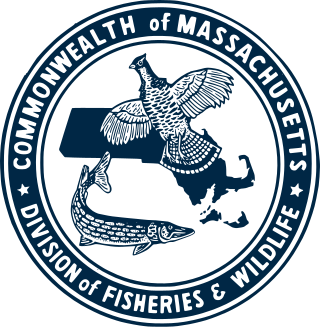
The United States Fish and Wildlife Service is an agency within the United States Department of the Interior dedicated to the management of fish, wildlife, and natural habitats. The mission of the agency is "working with others to conserve, protect, and enhance fish, wildlife, plants and their habitats for the continuing benefit of the American people."
The Virginia Department of Wildlife Resources is a department of the government of the U.S. state of Virginia that regulates wildlife conservation.

The Kentucky Department of Fish and Wildlife Resources, an agency of the Kentucky Tourism, Arts and Heritage Cabinet, is responsible for the conservation of wildlife resources and for boating projects in the state. A commissioner appointed by the Fish and Wildlife Commission heads the department. The commission—which oversees the department's commissioner and promulgates regulations governing fishing, hunting, and boating—is a nine-member bipartisan board appointed by the governor from a list of candidates nominated by active hunters and anglers in each of nine geographic districts in the state.

Snagging, also known as snag fishing, snatching, snatch fishing, jagging (Australia), or foul hooking, is a fishing technique for catching fish that uses sharp grappling hooks tethered to a fishing line to externally pierce into the flesh of nearby fish, without needing the fish to swallow any hook with its mouth like in angling. This is achieved by suddenly and vigorously pulling the line when movement is felt, causing the snag hook to "claw" into any fish unfortunate enough to be grappled by the hook points. Weighted multi-hook rigs can be used to increase chances of success, and modern technologies such as underwater video camera can also be used to visually aid and time the snagging.

Game laws are statutes which regulate the right to pursue and hunt certain kinds of wild animals and fish. The scope of game laws can include the following:

The Texas Parks & Wildlife Department (TPWD) is a Texas state agency that oversees and protects wildlife and their habitats. In addition, the agency is responsible for managing the state's parks and historical areas. Its mission is to manage and conserve the natural and cultural resources of Texas and to provide hunting, fishing, and outdoor recreation opportunities for the use and enjoyment of present and future generations.
The South Branch Wildlife Management Area is 1,092 acres (4.42 km2) of mixed oak-hickory woodlands and pastures in Hampshire and Hardy Counties, West Virginia, USA. The South Branch WMA consists of four separate tracts along the South Branch Potomac River around and south of the river gorge known as The Trough. It is known throughout the region for its dove, squirrel, deer, and wild turkey hunting. The WMA is owned by the West Virginia Division of Natural Resources.
The Allegheny Wildlife Management Area is located on 6,202 acres (25.1 km2) on two separate tracts of mixed oak-hickory woodlands in western Mineral County along the Allegheny Front. The large land tract of 5,034 acres (2,037.2 ha) is accessible via Pinnacle Road and Pine Swamp Road four miles (6 km) southwest of Keyser. The smaller tract of 1,168 acres (4.7 km2) is accessed by West Virginia Route 46 and Barnum Road about 6 miles (10 km) north from Elk Garden. The Barnum Road tract consists of old farm fields along the river and the ridgetop, connected by steep slopes.

A hunting license or hunting permit is a regulatory or legal mechanism to control hunting, both commercial and recreational. A license specifically made for recreational hunting is sometimes called a game license.
The Alabama Department of Conservation and Natural Resources (ADCNR) is the state agency responsible for the conservation and management of Alabama's natural resources including state parks, state lands, wildlife and aquatic resources. ADCNR also issues hunting and fishing licenses for the state. The department promotes wise stewardship and enjoyment of the state's natural resources through five divisions: Marine Resources, State Lands, State Parks and Wildlife and Freshwater Fisheries. Supporting those divisions are seven support sections: Accounting, Diversity and Recruiting, Engineering, Information and Education, Information Technology, Legal, and Personnel and Payroll.

The Chincoteague National Wildlife Refuge is a 14,000-acre (57 km2) wildlife preserve operated by the U.S. Fish & Wildlife Service. It is primarily located on the Virginia half of Assateague Island with portions located on the Maryland side of the island, as well as Morris Island and Wildcat Marsh. The refuge contains a large variety of wildlife animals and birds, including the Chincoteague Pony. The purpose of the refuge is to maintain, regulate and preserve animal and plant species as well as their habitats for present and future generations.
The Alaska Department of Fish and Game (ADF&G) is a department within the government of Alaska. ADF&G's mission is to protect, maintain, and improve the fish, game, and aquatic plant resources of the state, and manage their use and development in the best interest of the economy and the well-being of the people of the state, consistent with the sustained yield principle. ADF&G manages approximately 750 active fisheries, 26 game management units, and 32 special areas. From resource policy to public education, the department considers public involvement essential to its mission and goals. The department is committed to working with tribes in Alaska and with a diverse group of State and Federal agencies. The department works cooperatively with various universities and nongovernmental organizations in formal and informal partnership arrangements, and assists local research or baseline environmental monitoring through citizen science programs.
Rapidan Wildlife Management Area is a 10,326-acre (41.79 km2) Wildlife Management Area (WMA) in Madison and Greene counties, Virginia. It is composed of eight separate tracts of land along the eastern slope of the Blue Ridge Mountains; four of these adjoin Shenandoah National Park, and combined they share 25 miles (40 km) of boundary.

The Massachusetts Division of Fisheries and Wildlife, sometimes referred to as MassWildlife, is an agency of the Massachusetts Department of Fish and Game, within the Executive Office of Energy and Environmental Affairs. The Massachusetts Division of Fisheries and Wildlife (DFW) is responsible for the conservation - including restoration, protection and management - of fish and wildlife resources for the benefit and enjoyment of the public. MassWildlife was founded as a state fisheries commission in 1866 in response to citizen concerns about the loss of Atlantic salmon to dams and pollution. The agency's activities are mainly supported by revenue from the sale of hunting, trapping and fishing licenses, stamps and permits; returns from federal taxes on hunting and fishing equipment; various bond initiatives (primarily for land purchase. Additional funding is derived from voluntary donations from businesses, conservation organizations, and individuals.

The Montana Department of Fish, Wildlife and Parks (MFWP) is a government agency in the executive branch state of Montana in the United States with responsibility for protecting sustainable fish, wildlife, and state-owned park resources in Montana for the purpose of providing recreational activities. The agency engages in law enforcement activities to enforce laws and regulations regarding fish, wildlife, and state parks, and encourages safe recreational use of these resources.

The United States Fish and Wildlife Service Office of Law Enforcement contributes to Service efforts to manage ecosystems, save endangered species, conserve migratory birds, preserve wildlife habitat, restore fisheries, combat invasive species, and promote international wildlife conservation.

The Massachusetts Environmental Police is a Massachusetts, US, state government law enforcement agency, which is the primary enforcement agency of Massachusetts's boating and recreation vehicle laws and regulations and is responsible for registering boats, off-highway vehicles and snowmobiles in Massachusetts. The agency is also responsible for the enforcement of fish and game laws, including commercial and recreational harvesting of the living marine resources along the state's coastline.

Big Woods State Forest is a 2,188-acre (8.85 km2) state forest in Sussex County, Virginia. It was the first state forest property to be established in southeast Virginia.

Mattaponi Wildlife Management Area is a 2,542-acre (10.29 km2) Wildlife Management Area (WMA) in Caroline County, Virginia. Located west of Bowling Green, the area protects a mixture of wetlands and upland forests at the confluence of the Mattaponi and South rivers.

Big Woods Wildlife Management Area is a 4,173-acre (16.89 km2) Wildlife Management Area (WMA) in Sussex County, Virginia. It comprises two tracts of land; the 2,208-acre (8.94 km2) main tract, located immediately adjacent Big Woods State Forest, and the 1,965-acre (7.95 km2) Parker's Branch tract, located nearby.













